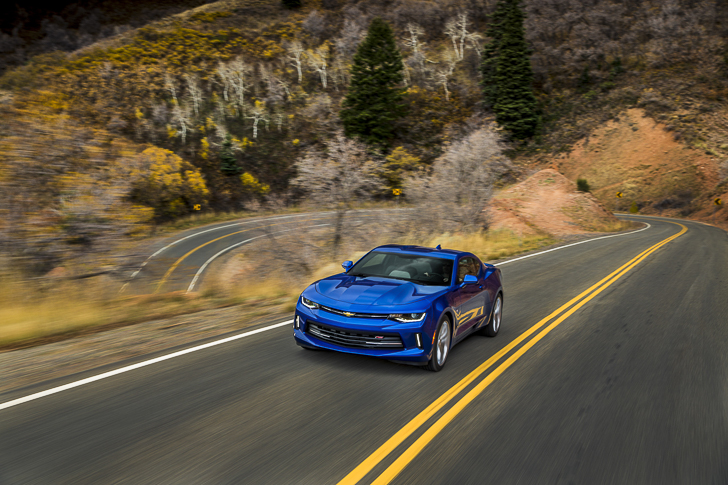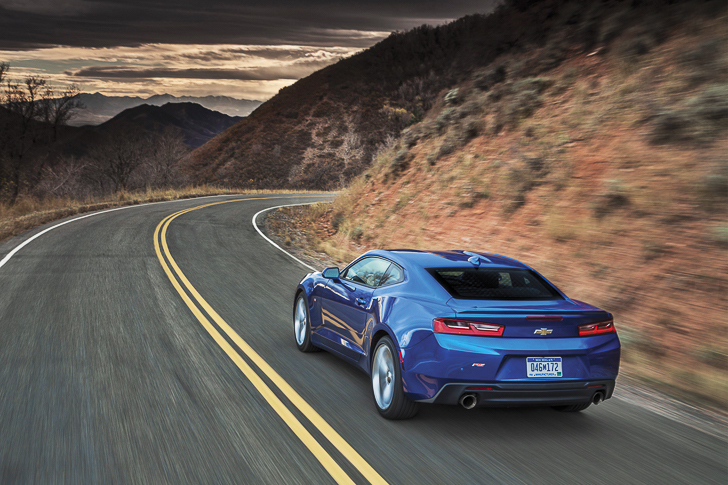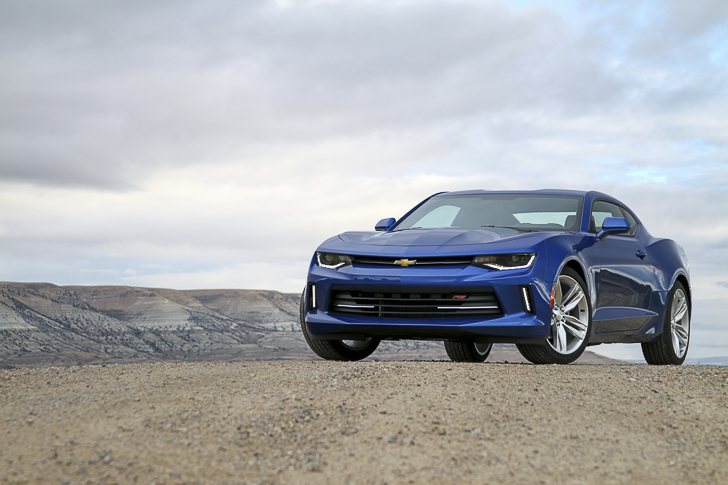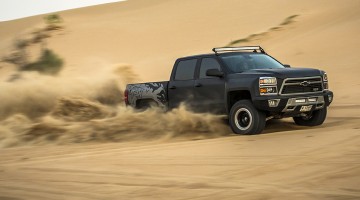The latest generation of of Chevrolet’s flagship muscle car has arrived, but has it changed for the better? crankandpiston finds out in the US o’ A
| Engine | Power | Torque | 0-100kph | Top speed | Weight | Basic price |
|---|---|---|---|---|---|---|
| V8, 6162cc | 455bhp @ 6000rpm | 455lb ft @ 4400rpm | 4.0sec (manual) | TBC | TBC | $53,400 |
Though we’re trying hard not to say it out-loud, there is one word on everyone’s lips today: ‘Mustang’.
It’s an inevitable comparison, for not only has Ford’s principal muscle car been a thorn in Chevrolet’s side across six generations since 1966, but much like the brand new #CamaroSix we’re testing today, the Mustang has also been revised to focus ‘more on performance, refinement and efficiency’, whilst still sticking like epoxy resin to its ‘muscle car heritage’. It’s much the same description we’ve been given of the new Camaro, and truth be told, that’s got us worried.
Though the Mustang turned out to be dynamically brilliant, its newfound civility and – urgh – practicality meant it had lost much of its blue collar, muscle car appeal. And since it seems to be following the same blueprint for 2016, might Chevrolet have fallen into the same bear trap with the new Camaro?
In terms of looks, it’s a solid ‘no’…
The more rounded, rather ‘cutesy’ demeanour of the fifth gen Camaro favoured heavily by Bumblebee and sorority girls alike has now hit the trashcan. In its place, courtesy of slick new headlights, ripped bonnet contours and a truly whopping front air intake, is something altogether more aggressive, and ultimately, better looking. Though I’ll admit the pinched rear wheel arches are slightly more awkward than their beefier outgoing counterparts, the overall look is a belter. Particularly in the Hyper Blue Metallic our test model is clad in, making the fact that this colour scheme is not coming to the region even more tragic.
All new then, save the Chevy bowtie and the SS badge, and it’s much the same underneath. The new chassis is both stiffer and leaner, renewed focus on manoeuvrability meaning the Camaro is also 57mm shorter, 28mm lower and 20mm narrower than before on a wheelbase 41mm smaller. To reduce structural rigidity (up by 28 per cent, apparently), the chassis incorporates ‘heavy’ use of aluminium rather than steel, attributing 4.2kg of the 90kg weight loss. Even the 6.2-litre V8 has dropped a belt loop.
Ah yes, the engine. Perhaps you were wondering when we’d get to that, since the V8 in our SS test model is essentially the same as that found in the Corvette Stingray. Producing 455bhp and a mirrored 455lb ft of torque, the Bowtie-clad newboy manages to hit 0-100kph in four seconds flat (when connected to the eight-speed 8L90 automatic at least), while Chevy has also kept a close eye on fuel efficiency. There’s even a 2-litre four-cylinder capable of 9.4L/100km. On a muscle car. That ‘M’ word we’re not supposed to mention springs to mind…
So, how does it drive?
Breathe a sigh of relief though, since the track-focused side of our extended jaunt from Los Angeles to the Vegas strip is pretty encouraging, even on a circuit as tight and technical as the Spring Mountain Motorsports Race Circuit. Off the line and down the main straight, pick-up from that 455bhp V8 is impressive. No sooner has first gear been housed via our optional six-speed manual gearbox (hooray!) than the rear tyres are already trying to destroy themselves as that mountainous bank of torque is sent in their direction. The same can also be felt in second gear, with wheel spin even traceable in third. So yes, really quite fast. Coupled with an appropriate ‘distinctive performance sound’ booming from those quad exhaust tips, it’s a welcome reminder of the Camaro’s muscle car DNA. Then we hit the first corner…
Calm down GM CEOs, it’s largely positive. Indeed, compared with the occasionally lurching nature of the outgoing model – whose understeer tendencies were saved only thanks to a low centre of gravity – the new Six features some impressive poise, a hallmark of not only that stiffened chassis, but also the suppleness of the faster-reacting Magnetic Ride Control active suspension, hitherto only available on the higher-spec ZL1. On the track the dampers remain taut to keep the balance in-check, and yet somehow on the road section of our test, the same setup produces a surprisingly dignified ride comfort. There’s still an edge to remind you that you’re piloting a 455bhp American sports car, but it’s a far from jarring ride across even the most choppy of surfaces. Mercifully, in the beautifully restyled cabin, the seating position has also been lowered, and while the roofline is still aggressively raked, sitting upright is actually possible now. You’re still unlikely to get more than two full-sized adults in this 2+2 sports car, but then that’s to be expected…
Back on-track, the V8 hanging over the front axle means there’s still a degree of front end pitch to contend with when throwing the muscular Chevy into an apex, but even at pace, the front wheels are rarely unsettled by the weight transfer, making the ability to carry momentum through the turns much easier than the previous model. It’s also into the tighter corners where I’m glad the formerly wooden middle pedal has been significantly upgraded.
For our first few runs we’re encouraged to keep the traction control on, the system lights flicking more-than-intermittently as the rear wheels try to step out. Only when our pleas have grown too much to bear do our genial hosts acquiesce, albeit for a couple of laps. And again, there’s significant improvement. Once again the back end steps out through the tighter corners, but less heave is required to draw them back into line. This is due in no small part to the revised power steering, the weighting of which from lock-to-lock is more consistent, encouraging you to really muscle the front end.
Verdict?
Yep. Muscle. But therein lies a quandary. On the whole, it’s hard to compare the fifth generation and the new Six, since quite honestly, they’re in different leagues. The new looks are appropriately menacing, the interior design and quality is excellent, the agility through the corners is greatly improved, the acceleration even more aggressive, the brakes no longer made of play dough, and the ride comfort more than supple enough for a three hour journey across California’s notoriously back-wrenching tarmac. Unquestionably the Camaro has hit a refinement and civility it never has done before. But as was the case with the Mustang, I’m not sure if that’s what we’re looking for in a muscle car?
Technical specifications available on page 2






